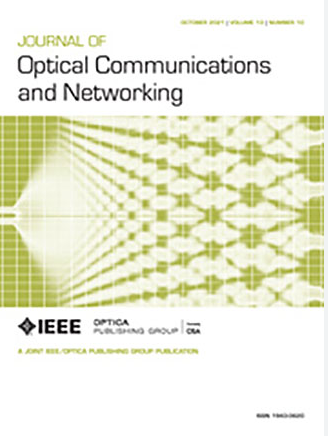在具有模式选择交换机的模式分复用网络中启用ROADM
IF 4.3
2区 计算机科学
Q1 COMPUTER SCIENCE, HARDWARE & ARCHITECTURE
引用次数: 0
摘要
模分复用(MDM)通过引入额外的复用维度来增强光通信系统。我们设计并验证了一种可重新配置的光分插复用器(ROADM)原型,它采用 MDM 作为光子系统,以数据中心互连和城域光网络为目标。我们的 MDM-ROADM 在每个节点上都采用了模式选择开关,对前三个横电(TE)模式进行选择性分插/多路复用。关键部件基于 220 纳米硅光子技术,采用亚波长光栅结构和反向设计方法。通过我们的工具 PreFab,基于机器学习的制造校正将模式选择性热光学移相器的模式选择性提高了 57%。我们还为两种模式开发了模式滤波器,在35纳米波长范围内,${{text{TE}}_0}$和${{text{TE}}_1}$的串扰分别为${-}{9}\;{\text{dB}}$和${-}{15}\;{\text{dB}}$。在 1555 nm 波长下使用 ${{text{TE}}_0}$ 和 ${{{text{TE}}_1}$ 模式进行的实验验证显示,80 Gb/s NRZ 和 40 Gbaud 的 PAM-4 传输的总有效载荷传输误码率分别为 1.1 次{10^{- 9}}$和 3.8 次{10^{- 3}}$。本文章由计算机程序翻译,如有差异,请以英文原文为准。
Enabling ROADM in mode division multiplexing networks with mode-selective switches
Mode division multiplexing (MDM) enhances optical communication systems by introducing an additional multiplexing dimension. We designed and validated a reconfigurable optical add/drop multiplexer (ROADM) prototype using MDM as an optical subsystem targeting data center interconnects and metro optical networks. Our MDM-ROADM employs a mode-selective switch at each node, selectively de/multiplexing the first three transverse-electric (TE) modes. Key components are based on 220 nm silicon photonics, using subwavelength grating structures and inverse design methodology. Machine learning-based fabrication correction, via our tool PreFab, improved mode selectivity by 57% for mode-selective thermo-optic phase shifters. We also developed mode filters for two modes with a crosstalk of ${-}{9}\;{\text{dB}}$ for ${{\text{TE}}_0}$ and ${-}{15}\;{\text{dB}}$ for ${{\text{TE}}_1}$ within a 35 nm wavelength range. Experimental validation using ${{\text{TE}}_0}$ and ${{\text{TE}}_1}$ modes at 1555 nm shows an aggregate payload transmission of 80 Gb/s NRZ and a PAM-4 transmission at 40 Gbaud with a bit error rate of $1.1 \times {10^{- 9}}$ and $3.8 \times {10^{- 3}}$ , respectively.
求助全文
通过发布文献求助,成功后即可免费获取论文全文。
去求助
来源期刊
CiteScore
9.40
自引率
16.00%
发文量
104
审稿时长
4 months
期刊介绍:
The scope of the Journal includes advances in the state-of-the-art of optical networking science, technology, and engineering. Both theoretical contributions (including new techniques, concepts, analyses, and economic studies) and practical contributions (including optical networking experiments, prototypes, and new applications) are encouraged. Subareas of interest include the architecture and design of optical networks, optical network survivability and security, software-defined optical networking, elastic optical networks, data and control plane advances, network management related innovation, and optical access networks. Enabling technologies and their applications are suitable topics only if the results are shown to directly impact optical networking beyond simple point-to-point networks.

 求助内容:
求助内容: 应助结果提醒方式:
应助结果提醒方式:


